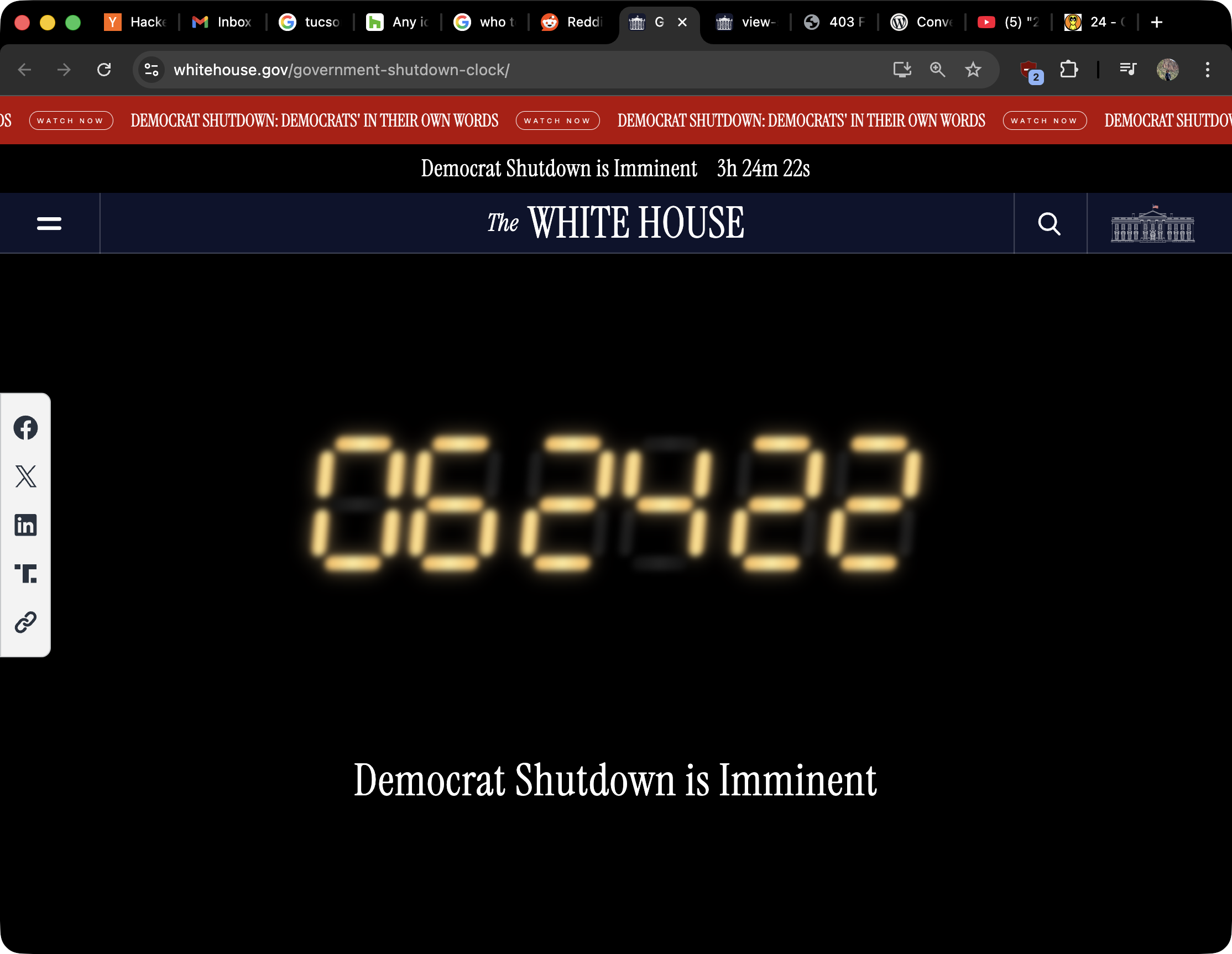Whenever I see a website trending, I can’t resist popping open the source code. Who else does this? Anyhoo, today’s curiosity: the US White House’s new Government Shutdown Clock (archive link).

A screenshot of the White House site, sporting a design strikingly similar to the popular TV show '24'
A Countdown Straight Out of ‘24’
The site shows a dramatic digital timer built with plain HTML, CSS, and a bit of JavaScript embedded in a WordPress custom block:
// console.log('Script starting...');
const segmentMap = {
0: ['a', 'b', 'c', 'd', 'e', 'f'],
1: ['b', 'c'],
2: ['a', 'b', 'd', 'e', 'g'],
3: ['a', 'b', 'c', 'd', 'g'],
4: ['b', 'c', 'f', 'g'],
5: ['a', 'c', 'd', 'f', 'g'],
6: ['a', 'c', 'd', 'e', 'f', 'g'],
7: ['a', 'b', 'c'],
8: ['a', 'b', 'c', 'd', 'e', 'f', 'g'],
9: ['a', 'b', 'c', 'd', 'f', 'g']
};
const endDate = new Date('October 1, 2025 00:00:00').getTime();
let lastSecond = -1;
function updateClock() {
// console.log('updateClock called');
let now = Date.now();
let distance = endDate - now;
if (0 > distance) {
setAllDigits(0);
return;
}
setAllDigits(Math.floor(distance / 1000));
setTimeout(updateClock, 100);
}
function setDigit(index, value) {
if (value > 9 || value < 0)
value = 0;
let digit = document.getElementById('d' + index);
if (!digit) {
// console.error('Digit ' + index + ' not found');
return;
}
digit.querySelectorAll('.segment')
.forEach(s => s.classList.remove('lit'));
(segmentMap[value] || []).forEach(cls => {
let seg = digit.querySelector('.' + cls);
if (seg)
seg.classList.add('lit');
});
}
function setAllDigits(value) {
// console.log('setAllDigits ' + value);
// value is total seconds remaining
let hours = Math.floor(value / 3600);
let minutes = Math.floor((value % 3600) / 60);
let seconds = value % 60;
let d1 = Math.floor(hours / 10) % 10;
// hours tens
let d2 = hours % 10;
// hours ones
let d3 = Math.floor(minutes / 10);
// minutes tens
let d4 = minutes % 10;
// minutes ones
let d5 = Math.floor(seconds / 10);
// seconds tens
let d6 = seconds % 10;
// seconds ones
setDigit(1, d1);
setDigit(2, d2);
setDigit(3, d3);
setDigit(4, d4);
setDigit(5, d5);
setDigit(6, d6);
}
updateClock();
document.addEventListener('click', function() {
document.querySelector('#countdown-audio audio').play();
});
So far, so good—numbers tick down, digits light up.
I found there are some similarities to the open-source code published here. So if that’s your code, congrats, you helped author the White House’s website.
PS: I love GitHub’s Code Search product. I believe it’s seriously underutilized.
But then I spotted that #countdown-audio element. And a click handler.
Wait. Was this thing supposed to have a sound effect?
The Bug
Yep. On first click, the page tries to play audio. But it fails.
Here’s why:
<figure id="countdown-audio" class="wp-block-audio">
<audio
controls
src="https://stage-wh47.go-vip.net/wp-content/uploads/2025/09/24_countdown-1.mp3"
autoplay
loop
></audio>
</figure>
The audio player mistakenly points to their staging domain (go-vip.net) instead of production (whitehouse.gov). Which means no audio, just silence.
Normally, that’s a rookie bug that happens to all of us at some point (if we’re storing HTML in a database). But here, it was a blessing.
The Sound They Meant to Use
Correct the path, and you’ll discover what they were really trying to embed: the iconic ticking from Fox’s hit TV show “24” (the rights of which now owned by Disney).
That audio wasn’t licensed—it was ripped from a 2013 YouTube upload.
On YouTube, Disney tolerates it thanks to their Content ID system. But outside of YouTube, served raw as an MP3 with no visible attribution? Guys, that’s infringement.
Why the Bug Was a Blessing
Thanks to that staging slip, the White House unknowingly saved itself from breaking its own copyright rules…
Coincidence: Disney is historically cracking down on copyright infringement today.
Instead of headlines about “White House Violates Disney Copyright”, which would be familiar, they ironically created a cleaner, more original website.
How They Could Fix It (But Shouldn’t)
Technically, the fix is trivial: use relative paths instead of absolute paths for the MP3, or modify the custom block to point to the proper production path.
But legally? Not so smart. Better options include:
Buying a license from Disney.
Embed the YouTube video directly.
Hiring a freelancer to make a knockoff beep.
Letting AI like Suno synthesize a fair-use alternative.
Or—probably the wisest move—just leaving it broken.
The Takeaway
A broken file path usually spells disaster. But in this case, it acted as a bug-driven legal compliance tool.
Sometimes the best sound effect is none at all.
Disclaimer: Just my own views here. I believe in upholding copyright, fair use, and proper licensing. In the past, I have worked for Disney as a full-time content producer.
Discuss this post on Hacker News and Reddit.